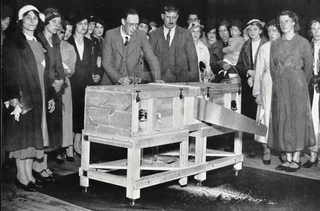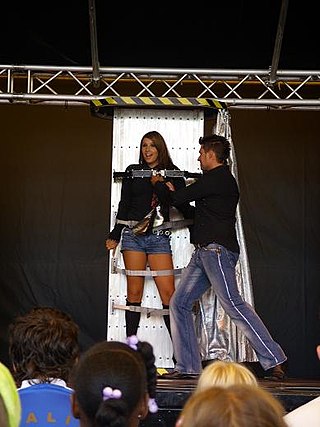Related Research Articles
Escapology is the practice of escaping from restraints or other traps. Escapologists escape from handcuffs, straitjackets, cages, coffins, steel boxes, barrels, bags, burning buildings, fish-tanks, and other perils, often in combination.

The cups and balls is a performance of magic with innumerable adaptations. Street gambling variations performed by conmen were known as Bunco Booths. A typical cups and balls routine includes many of the most fundamental effects of magic: the balls can vanish, appear, transpose, reappear and transform. Basic skills, such as misdirection, manual dexterity, sleight of hand, and audience management are also essential to most cups and balls routines. As a result, mastery of the cups and balls is considered by many as the litmus test of a magician's skill with gimmick style tricks. Magician John Mulholland wrote that Harry Houdini had expressed the opinion that no one could be considered an accomplished magician until he had mastered the cups and balls. Professor Hoffman called the cups and balls "the groundwork of all legerdemain".

Sawing a woman in half is a generic name for a number of stage magic tricks in which a person is apparently cut or divided into two or more pieces.

Metamorphosis is the name of a stage illusion invented by John Nevil Maskelyne, but most often associated with famous escape artist Harry Houdini and performed to some renown by The Pendragons, among others. It is also known amongst magicians as the Substitution Trunk.

The bullet catch is a stage magic illusion in which a magician appears to catch a bullet fired directly at them — often in the mouth, sometimes in the hand or sometimes caught with other items such as a dinner plate. The bullet catch may also be referred to as the bullet trick, defying the bullets or occasionally the gun trick.
Intellectual rights to magic methods refers to the legal and ethical debate about the extent to which proprietary or exclusive rights may subsist in the methods or processes by which magic tricks or illusions are performed. It is a subject of some controversy.
Exposure in magic refers to the practice of revealing the methods of magic tricks.

A predicament escape is any form of magic trick or escapology stunt in which the performer is trapped in an apparently dangerous situation and is required to escape from it. Classic examples include the Table of Death, Houdini's Chinese Water Torture Cell, Princess Tenko's escape from an exploding boat and the Upside Down Suspended Straitjacket escape, in which a performer is suspended high in the air from a burning rope.
Val Valentino is an American magician. Valentino is best known for starring in the television show Breaking the Magician's Code: Magic's Biggest Secrets Finally Revealed, where he exposes the methods behind numerous classic magic tricks and illusions on the Fox network. In the specials, he used the stage name the Masked Magician and concealed his true identity by wearing a mask with a squid like design, being aware of the stigma amongst the magic community with publicly exposing tricks. As the finale to the final special, Valentino revealed his identity as the Masked Magician, garnering some notoriety amongst the magic community, and instigating several lawsuits.
Breaking the Magician's Code: Magic's Biggest Secrets Finally Revealed is a series of television shows in which the methods behind magic tricks and illusions are explained. In its original incarnation there were four shows in 1997–1998 and a special in 2002 broadcast on the Fox network in the United States, and on Sky and ITV in the United Kingdom. In 2008–2009, a new series of thirteen shows was broadcast by MyNetworkTV in the United States and ITV4 in the United Kingdom. On May 1, 2012, reruns of the first season began airing on BIO in the United States.

The Chinese Water Torture Cell is a predicament escape made famous by Hungarian-American magician Harry Houdini. The illusion consists of three parts: first, the magician's feet are locked in stocks; next, he is suspended in mid-air from his ankles with a restraint brace; finally, he is lowered into a glass tank overflowing with water and the restraint is locked to the top of the cell.
The Guillotine is a magic trick where it appears that a blade of a guillotine passes through a person's neck without harming them. Variations on the theme have been performed for hundreds of years, with documented examples appearing in print in the 16th century. The most common modern variation is the finger guillotine or finger chopper, a pocked-sized version that appears to chop off the magician's finger.

The Assistant's Revenge is a transposition illusion in which two performers change places. It was created by magician and inventor Robert Harbin.
André Kole was an American magician and inventor of magical effects. He was also a committed Christian and a public speaker for the evangelical group Campus Crusade for Christ. He was also known for using his magical knowledge to debunk frauds and hoaxes.

Conjuring is an illustrated book about conjuring, or magic, by James "The Amazing" Randi, who himself was a magician and escape artist. Drawing on his extensive knowledge and experience in the field, Randi offers a series of brief biographies of a variety of noteworthy magicians and their unique styles, including Harry Houdini, Chung Ling Soo, Harry Blackstone Sr., Harry Blackstone Jr., Howard Thurston, and many others. He also provides an overview of several genres of magic such as stage magic, escapology, and mentalism, and of specific tricks such as the bullet catch. Reviews of the book were mainly positive.

The Drill of Death is a large-scale stage illusion in which a performer appears to be impaled on a giant drill. It was created by magician André Kole and illusion designer Ken Whitaker for magician Melinda Saxe. It was one of Saxe's signature tricks and featured as a highlight in her various First Lady of Magic shows.
The World's Most Dangerous Magic was the title of two American television specials showcasing illusion and escapology acts, which were made for the NBC network. The first was originally broadcast on 27 April 1998 and the second, titled The World's Most Dangerous Magic 2, was initially aired on 2 May 1999.

Magic, which encompasses the subgenres of illusion, stage magic, and close-up magic, among others, is a performing art in which audiences are entertained by tricks, effects, or illusions of seemingly impossible feats, using natural means. It is to be distinguished from paranormal magic which are effects claimed to be created through supernatural means. It is one of the oldest performing arts in the world.

A levitation illusion is one in which a magician appears to defy gravity by making an object or person float in the air. The subject may appear to levitate unassisted, or it may be performed with the aid of another object in which case it is termed a "suspension".
References
- ↑ "Illusion rights page at www.magicauction.com" . Retrieved 2007-03-05.
- ↑ ""Proprietary designs and Intellectual Property information for new or used illusions" on the Zigmont Magic website" . Retrieved 2007-03-06.
- ↑ ""Biographies HIJ" page of the "Magic Inventors" project at the Magic Nook website" . Retrieved 2007-03-06.
- ↑ "LA Superior Court BC190153, Robert J. Gurtler pka Andre Kole v. Nash Entertainment, Bruce Nash, Fox Broadcasting Co". Entertainment Law Digest. 2 (11). Courthouse News Service. May 1997. Archived from the original on 2007-09-28. Retrieved 2009-06-17.
- ↑ Brownfield, Paul (31 October 1998). "Fox Isn't Disillusioned as Masked Magician Series Ends". Los Angeles Times (online). Archived from the original on 10 October 2012. Retrieved 17 June 2009.
